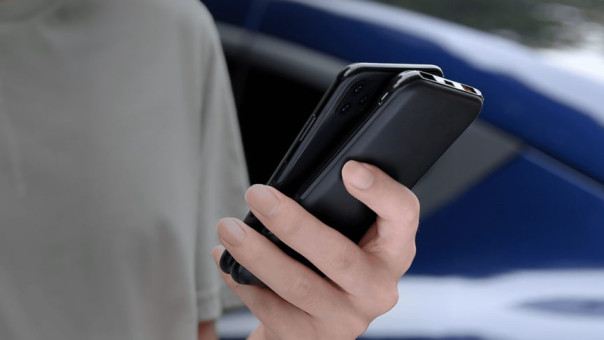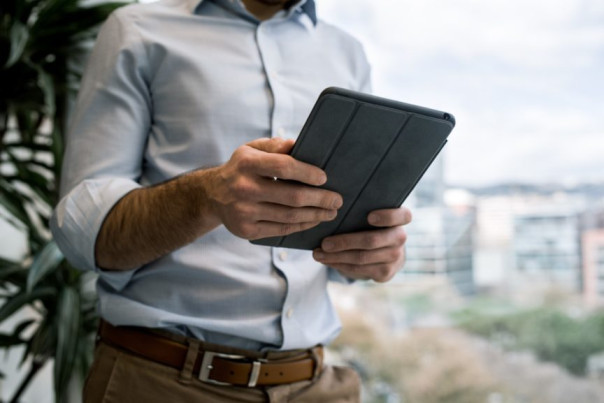Portable chargers are plentiful these days, and manufacturers are battling it out to differentiate each new model. As firms jam more ports and functions into ever-smaller shells, bulky batteries, limited capacity, and slow charging are no longer acceptable.
The Aukey Sprint wireless power bank is a nice example, with features such as wireless charging and power delivery (PD), as well as several USB ports and a sleek design. Extra features and lower sizes are two things that travellers look for in their electronics, and this power bank promised both, which caught my curiosity. Aukey sent me a review sample so that I could see for myself if it lived up to its claims.
Features and Specifications
The Aukey Sprint Wireless Power Bank (model number PB-Y25) is a compact black slab with few identifying characteristics. It’s about the same size as a modern smartphone and could easily be mistaken for one that’s face-down on a table. The smooth plastic top has only the Aukey logo on it, while the left side has a small power button and four tiny LEDs that show how much battery capacity is left.
On the right side, there’s a single micro-USB connector, and on the front, there’s a USB-C port and two USB-A ports. The normal compliance information, model number, and power requirements are listed at the bottom:
Specifications
- 8000 mAh
- 5.8 x 3 x 0.6 in (14.7 x 7.5 x 1.4cm)
- 7 oz (198 g)
- In: micro-USB, USB-C. Out: USB-C, 2x USB-A, wireless
- Max output (total): 18W
- Max output per port: USB-C PD: 18W, USB-A QC 3.0: 18W, USB-A: 12W, Wireless: 5W
The power bank’s total maximum output is 18 watts. That’s also the combined maximum output of the USB-C and USB-A ports that support QC 3.0. The other USB-A port can deliver up to 12 watts, while Qi wireless charging can deliver up to 5 watts.
The power bank may be charged using either a micro-USB or USB-C connector. It will be faster if you use a good wall charger instead of the latter. However, it’s worth noting that there’s no pass-through charging, which means you can’t charge the power bank while it’s charging something else.
Real-World Testing
The power bank came packaged in a compact cardboard box with a warranty card, user instructions, and a short USB-C to USB-C connection. It was small enough to put in a jeans pocket and was approximately the same size as my phone. It was time to begin testing after topping off the charge level. I was able to charge a Pixel 2 smartphone at up to 10W and a OnePlus 6T at up to 6.4W using the USB-C port, which is approximately the same as my typical wall charger.
I got slightly over 15W out of it when I connected it to a laptop (which it isn’t rated for). That won’t be enough to charge the laptop battery, but it will buy you some time if you’re in a hurry to do anything before it runs out of juice. When it comes to USB-A ports, the QC 3.0 port has a greater output rating than the conventional one, which I noticed throughout my tests. When it came to charging the Pixel 2, I got a maximum of 8W from the former and 6.4W from the latter.
Charging two, three, or even four gadgets at the same time, whether cable or wirelessly, was a breeze. Of course, with numerous devices connected, the 18W overall output became an issue, but running four devices from an 8000mAh battery feels more like something I’d do in a review than in real life. I used an iPhone XS instead because neither of the three phones supports wireless charging.
With a cable, charging was as simple as plugging both ends in, while wireless charging needed a little more effort. A double-press of the power button is required to enable wireless charging. If you take the phone off the charger or move it away from the charging location for a few minutes, you’ll have to double-press the power button to get it to turn on again.
The “sweet spot” for placing your phone is also rather small, necessitating some trial and error before you hear the reassuring beep that indicates charging has begun. On a similar note, when charging wirelessly, the case’s smoothness is a visible issue. Because there’s almost no friction, your phone will slide around on the power bank with every bump and movement if it’s similarly slick. You won’t have any issues if you have a case on your phone or if the base of your phone has any grip.
But what if you’re using a “bare” iPhone? Expect a few issues with wireless charging disconnections and retrieving your phone from alongside the power bank. Wireless charging worked perfectly with the phone in the right spot and the power bank on a flat, sturdy surface. It’s just half as quick as a cable at best, so it’s better for overnight or top-up charging rather than when you’re in a rush.
Utilizing wireless charging, adding 10% more energy to the iPhone XS took 22 minutes, and using a Lightning connection took little less than ten minutes. When it comes to charging the power bank itself, there are two options: micro-USB and USB-C. If you use a quality PD wall charger, you can get up to 10W from the former and 18W from the latter. That matches what I noticed in my testing: a steady 9.1W while charging via micro-USB and 16.5W when charging via USB-C.
This equates to a substantially faster charging time, so choose the USB-C port if you need to charge this power bank rapidly. Despite the fact that the handbook explicitly states that you cannot charge anything from the power bank while it is being charged, I was determined to give it a shot. Unfortunately, whether I tried cable or wireless charging, the handbook was correct.
Verdict
The Aukey Sprint wireless power bank is an excellent product in general. It’s compact and slim, with an 8000mAh capacity that’ll charge any phone at least once, if not twice, without making the charger too heavy. Whether you use USB-C or the QC 3.0 port for wired charging, it’s a breeze. In the real world, charging several devices doesn’t take long, and wireless charging, while sluggish and finicky, works well as long as the power bank is on a level, stable surface.
However, the lack of pass-through charging appears to be a squandered opportunity. It would be really convenient to be able to put in the power bank, place my phone on top, and then dump them both fully charged into my bag a few hours later. A rough surface, at least on the top, would also aid wireless charging dependability. Because the phone moves around so easily and wireless charging disconnects so quickly, using wireless charging on the go is more difficult than it needs to be.
Despite its faults, the Aukey Sprint Wireless is still a viable option if you need a small power bank with a range of charging options. You could do a lot worse for the money if quick charging and wireless power away from home are crucial to you.






![HubSpot CRM Review: Is It Worth It in 2025? [Full Expert Breakdown]](https://radical.fm/wp-content/uploads/2025/08/1-10-360x180.png)


